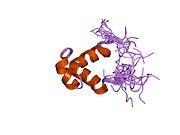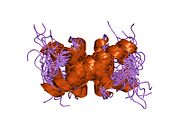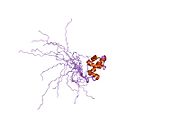
P300/CBP-associated factor (PCAF), also known as K(lysine) acetyltransferase 2B (KAT2B), is a human gene and transcriptional coactivator associated with p53.

Histone deacetylase 1 (HDAC1) is an enzyme that in humans is encoded by the HDAC1 gene.

Paired amphipathic helix protein Sin3a is a protein that in humans is encoded by the SIN3A gene.

Myocyte-specific enhancer factor 2C also known as MADS box transcription enhancer factor 2, polypeptide C is a protein that in humans is encoded by the MEF2C gene. MEF2C is a transcription factor in the Mef2 family.

Interferon regulatory factor 2 is a protein that in humans is encoded by the IRF2 gene.

Transformation/transcription domain-associated protein, also known as TRRAP, is a protein that in humans is encoded by the TRRAP gene. TRRAP belongs to the phosphatidylinositol 3-kinase-related kinase protein family.

Histone acetyltransferase KAT2A is an enzyme that in humans is encoded by the KAT2A gene.
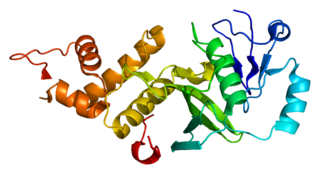
Histone acetyltransferase KAT5 is an enzyme that in humans is encoded by the KAT5 gene. It is also commonly identified as TIP60.

Recombination signal binding protein for immunoglobulin kappa J region is a protein that in humans is encoded by the RBPJ gene.

Histone H3.2 is a protein that in humans is encoded by the HIST2H3C gene.

Myocyte-specific enhancer factor 2D is a protein that in humans is encoded by the MEF2D gene.

Alpha-globin transcription factor CP2 is a protein that in humans is encoded by the TFCP2 gene.

Transcriptional adapter 3-like is a protein that in humans is encoded by the TADA3 gene. Cytogenetic location: 3p25.3

Histone acetyltransferase KAT7 is an enzyme that in humans is encoded by the KAT7 gene. It specifically acetylates H4 histones at the lysine12 residue (H4K12) and is necessary for origin licensing and DNA replication. KAT7 associates with origins of replication during G1 phase of the cell cycle through complexing with CDT1. Geminin is thought to inhibit the acetyltransferase activity of KAT7 when KAT7 and CDT1 are complexed together.

Lysine N-methyltransferase 2C (KMT2C) also known as myeloid/lymphoid or mixed-lineage leukemia protein 3 (MLL3) is an enzyme that in humans is encoded by the KMT2C gene.

Transcription initiation protein SPT3 homolog is a protein that in humans is encoded by the SUPT3H gene.

Achaete-scute complex homolog 2 (Drosophila), also known as ASCL2, is an imprinted human gene.

Retinoblastoma-binding protein 5 is a protein that in humans is encoded by the RBBP5 gene.
Amino acid response is the mechanism triggered in mammalian cells by amino acid starvation.
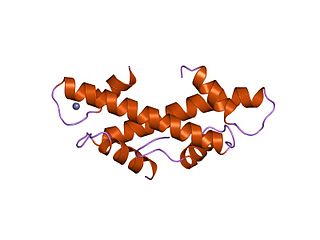
The TBP-associated factors (TAF) are proteins that associate with the TATA-binding protein in transcription initiation. It is a part of the transcription initiation factor TFIID multimeric protein complex. It also makes up many other factors, including SL1. They mediate the formation of the transcription preinitiation complex, a step preceding transcription of DNA to RNA by RNA polymerase II.

























